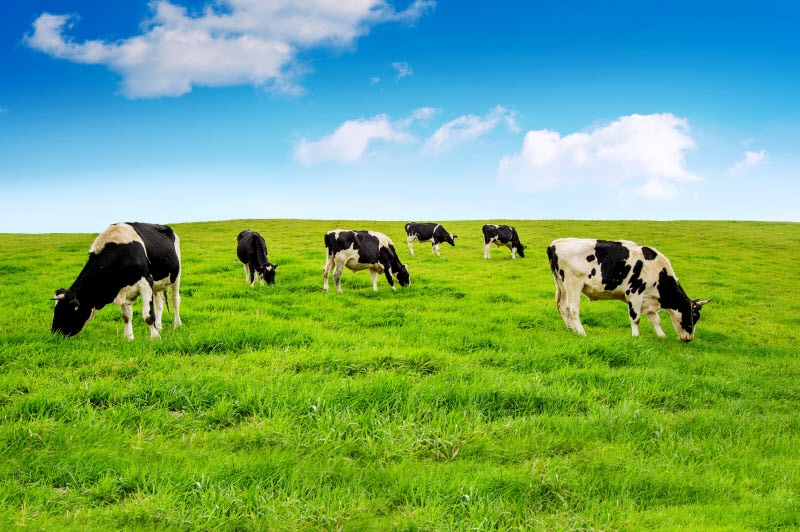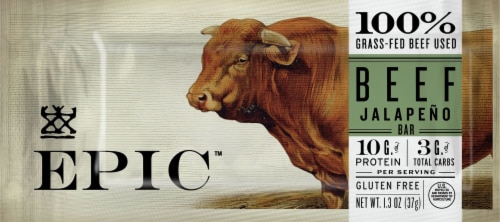[vc_row][vc_column][vc_column_text]You often see food from animals that’s tagged as “grass fed.” But what does that mean?
Unfortunately, there’s no strict definition of grass-fed meat and dairy products. The situation becomes even cloudier when you consider that these products might also be labeled as “organic” or “all natural.”
Foods that may be designated as grass-fed include:

What does “grass fed” mean?
If you search online, you’ll find slightly different definitions of “grass fed.” But this
definition from North Carolina’s N.C. Cooperative Extension neatly summarizes the meaning of this term:
The grass-fed claim means that these animals had access to pasture their entire lives and were not fed grains. There is also a grass-finished claim, which means the animal may have been fed grains at some point in its life, and should have the percentage of grain to grass-fed somewhere on the label.
The U.S. Department of Agriculture (USDA) further explains that
“grass fed” means grass and forage must be the source of an animal’s life, except milk consumed before weaning. Under this definition, an animal also can feed on things like hay, legumes and cereal grains in the vegetative (pre-grain) state.
What does a grass-fed designation mean?
At least two organizations,
A Greener World and the
American Grassfed Association, provide third-party certification of grass-fed foods. Only products that adhere to these groups’ guidelines can bear their logos.
A Greener World says its grass-fed designation means a product comes from:
- Animals fed a diet of only grass and forage.
- Animals raised outdoors on pasture or range land.
- Independent farms managed according to “the highest welfare and environmental standards.”
At the American Grassfed Association, grass-fed certification can be earned if animals are:
- Fed a diet of only grass and forage.
- Raised on pastures and aren’t confined.
- Never treated with antibiotics or added growth hormones.
- Born and raised on family farms in the U.S.
Meanwhile, the USDA offers a
certification program for small-scale meat producers. The Grass Fed Small and Very Small Producer Program lets farmers with fewer than 50 calves (baby cows) per year or fewer than 100 ewes (baby lambs) per year market their meat products as grass-fed. To qualify for the program, a small-scale operation must follow USDA standards for grass-fed meat.
Keep in mind that grass-fed beef typically costs more to produce than conventional beef.
“Because grass-fed [cattle are] eating a diet lower in calories and energy, it takes longer to get to the proper weight and finish, which is the amount of fat an animal has. It also takes more space to provide enough forage for these animals,” says N.C. Cooperative Extension. “This extra time on the farm is why grass-fed beef often has a price premium.”
N.C. Cooperative Extension adds that conventional beef tends to contain more marbling, contributing to enhanced flavor and tenderness compared with grass-fed beef.
What are the health benefits of grass-fed foods?
OK, so a product bears a label indicating it comes from a grass-fed animal. But should you buy it? What health benefits would you gain?
Many of the
health benefits of grass-fed products that experts mention are associated with beef from grass-fed cattle. Benefits cited in a peer-reviewed study published in August 2024 by Scientific Reports include:
- High level of antioxidants such as beta-carotene and vitamin E.
- High level of omega-3 fatty acids, which support heart and brain health, and help decrease inflammation.
- Favorable balance of omega-3 and omega-6 fatty acids. Omega-6 fatty acids help stimulate skin and hair growth, promote bone health, regulate metabolism and maintain the reproductive system, according to the Icahn School of Medicine at Mount Sinai.
- Low level of saturated fat, which can raise the amount of bad cholesterol in your blood and increase your risk for heart attack or stroke.
Despite that study’s findings, the Mayo Clinic declares that there’s “
limited long-term research to definitively prove that grass-fed beef is better for you” than beef from traditionally raised cattle.
In terms of fat content, the Mayo Clinic recommends that when shopping for beef — whether it's grass-fed beef or another kind of beef — you should look for lean beef. Lean beef contains as much as 10% fat.
The Grass Roots’ Farmers Cooperative, whose farms offer beef and other meats, further suggests
seeking out beef producers that:
- Raise their cattle on non-GMO pastures.
- Pay farmers a living wage.
- Ensure safe working conditions.
- Practice regenerative agriculture.
[/vc_column_text][/vc_column][/vc_row][vc_row][vc_column][vc_text_separator title="Featured Products" border_width="2"][vc_row_inner equal_height="yes" content_placement="middle" gap="35"][vc_column_inner width="1/3"][vc_single_image image="181097" img_size="full" alignment="center" onclick="custom_link" img_link_target="_blank" css=".vc_custom_1735569512597{padding-right: 7% !important;padding-left: 7% !important;}" link="https://www.vitacost.com/codeage-grass-fed-bone-marrow-bovine-glandular-superfood-supplement"][/vc_column_inner][vc_column_inner width="1/3"][vc_single_image image="181096" img_size="full" alignment="center" onclick="custom_link" img_link_target="_blank" css=".vc_custom_1735569530612{padding-right: 7% !important;padding-left: 7% !important;}" link="https://www.vitacost.com/orgain-grass-fed-21g-whey-protein-powder-pasture-raised-non-gmo-vanilla-bean"][/vc_column_inner][vc_column_inner width="1/3"][vc_single_image image="181095" img_size="full" alignment="center" onclick="custom_link" img_link_target="_blank" css=".vc_custom_1735569545427{padding-right: 7% !important;padding-left: 7% !important;}" link="https://www.vitacost.com/annies-homegrown-organic-grass-fed-shells-white-cheddar-macaroni-cheese"][/vc_column_inner][/vc_row_inner][/vc_column][/vc_row]




